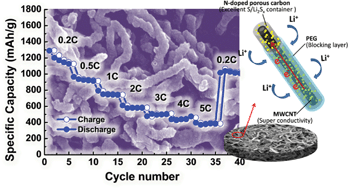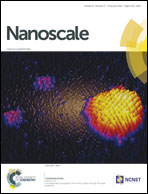A dual coaxial nanocable sulfur composite for high-rate lithium–sulfur batteries†
Abstract
Lithium–sulfur batteries have great potential for some high energy applications such as in electric vehicles and smart grids due to their high capacity, natural abundance, low cost and environmental friendliness. But they suffer from rapid capacity decay and poor rate capability. The problems are mainly related to the dissolution of the intermediate polysulfides in the electrolyte, and to the poor conductivity of sulfur and the discharge products. In this work, we propose a novel dual coaxial nanocable sulfur composite fabricated with multi-walled nanotubes (MWCNT), nitrogen-doped porous carbon (NPC) and polyethylene glycol (PEG), i.e. MWCNTs@S/NPC@PEG nanocable, as a cathode material for Li–S batteries. In such a coaxial structure, the middle N-doped carbon with hierarchical porous structure provides a nanosized capsule to contain and hold the sulfur particles; the inner MWCNTs and the outer PEG layer can further ensure the fast electronic transport and prevent the dissolution of the polysulfides into the electrolyte, respectively. The as-designed MWCNT@S/NPC@PEG composite shows good cycling stability and excellent rate capability. The capacity is retained at 527 mA h g−1 at 1 C after 100 cycles, and 791 mA h g−1 at 0.5 C and 551 mA h g−1 at 2 C after 50 cycles. Especially, the high-rate capability is outstanding with 400 mA h g−1 at 5 C.


 Please wait while we load your content...
Please wait while we load your content...